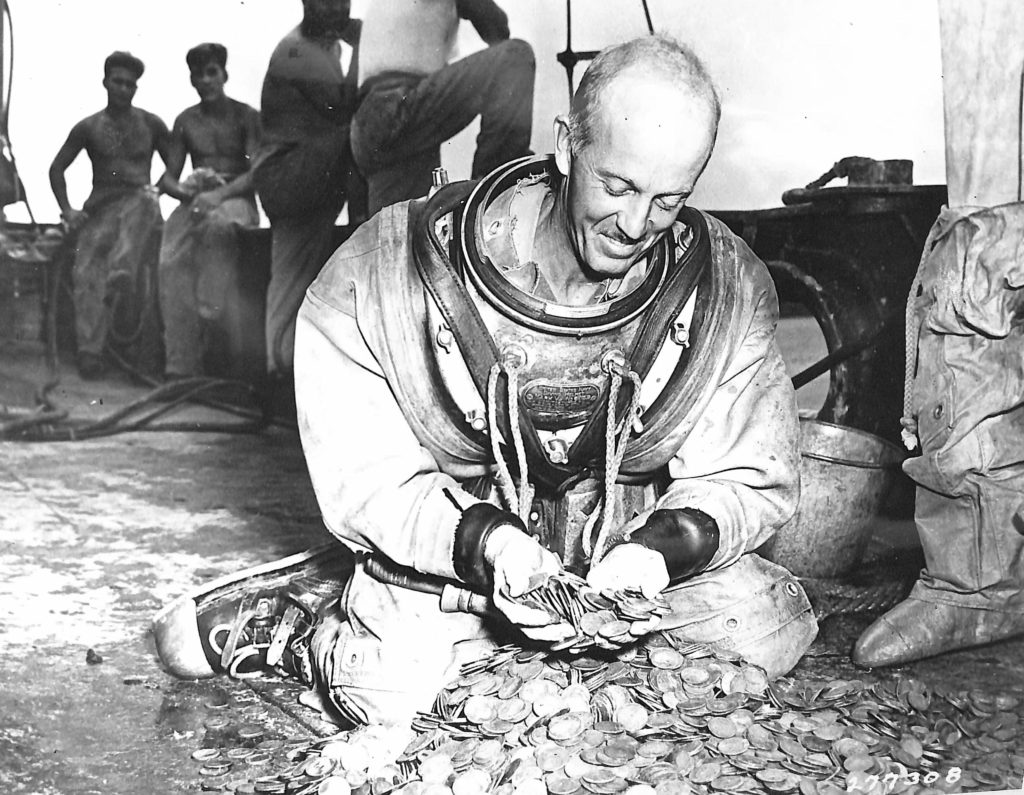
Zc274.T/Sgt. Harrison T. Martin of San Francisco, Calif., one of the divers detailed to recover millions (17-unreadable) of pesos from Manila Bay, is on board a salvage ship on the 2nd Nov 1945. He is looking at the silver recovered so far. Signal Corps Photo from Yank (S/Sgt. Ed Wergeles}. This photo was sent to me by the CDSG leader Glen Williford; thanks Glen.
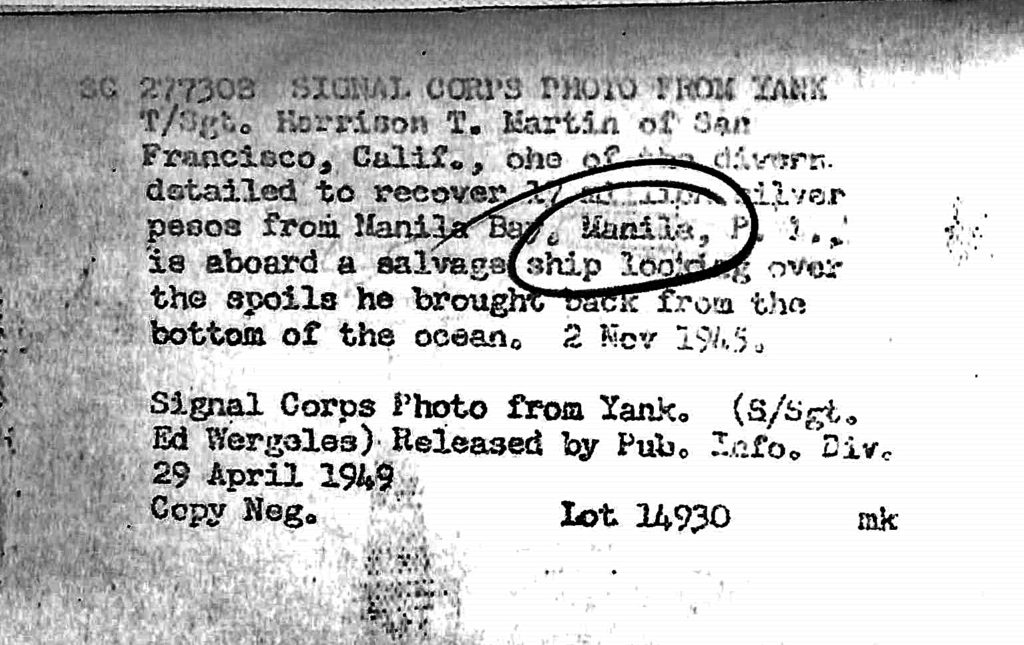
Zc275, the description in back of picture Zc274, a photo from Yank (S/Sgt., Ed. Wergeles} about T/Sgt. Harrison T. Martin of San Francisco, Calif., looking at the silver recovered from Manila Bay Nov. 1945.
The Japanese forced Navy Divers to recover that silver in Manila Bay (Caballo Bay).
These two images came from this URL thread (from armyjunk) in the Corregidor forum and tell the story of the Japanese forcing U.S. Navy POW divers recover the Philippine silver dumped in Caballo Bay in 1942. The story was original written by John G. Hubbell, an author. Click here!
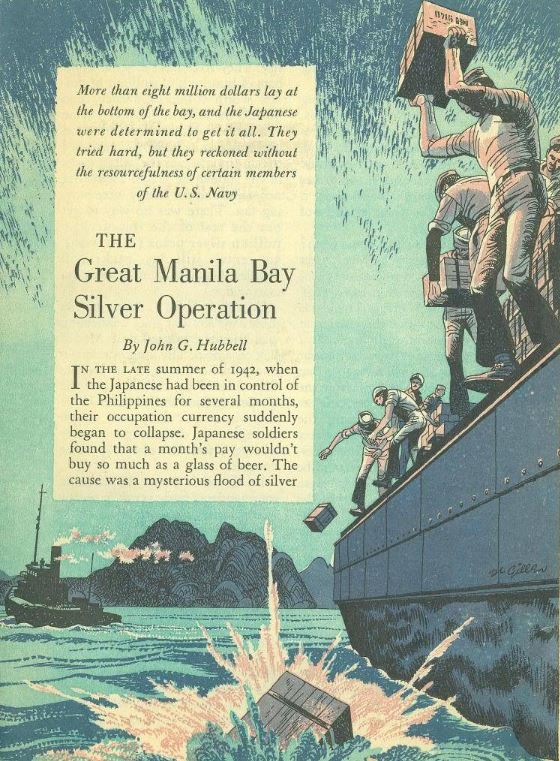
Zc282. A drawing from armyjunk’s thread in the Corregidor forum about U.S, Forces dumping silver into Caballo Bay.
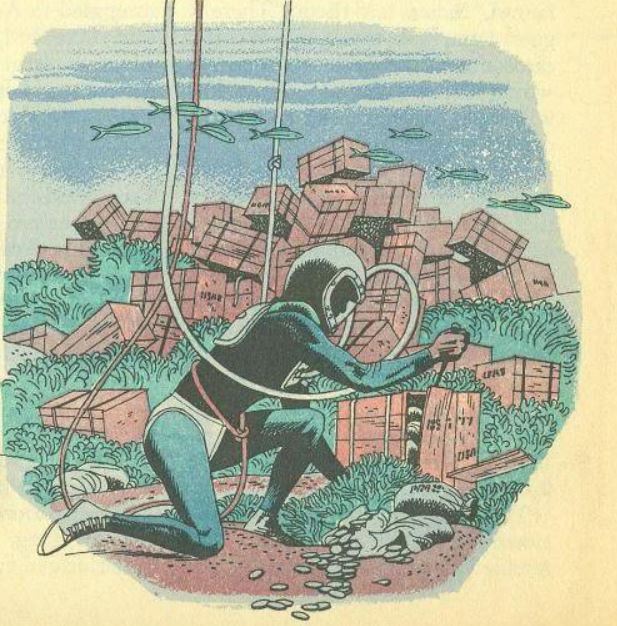
Zc283. A drawing from armyjunk’s thread in the Corregidor forum about U.S. POWs of the Japanese recovering silver in Caballo Bay.
Robert C Sheats was one of those divers and later he wrote this book: One Man’s War: Diving as a Guest of the Emperor. A good friend and shipmate of mine worked for him as a diver after the war and told me about it.
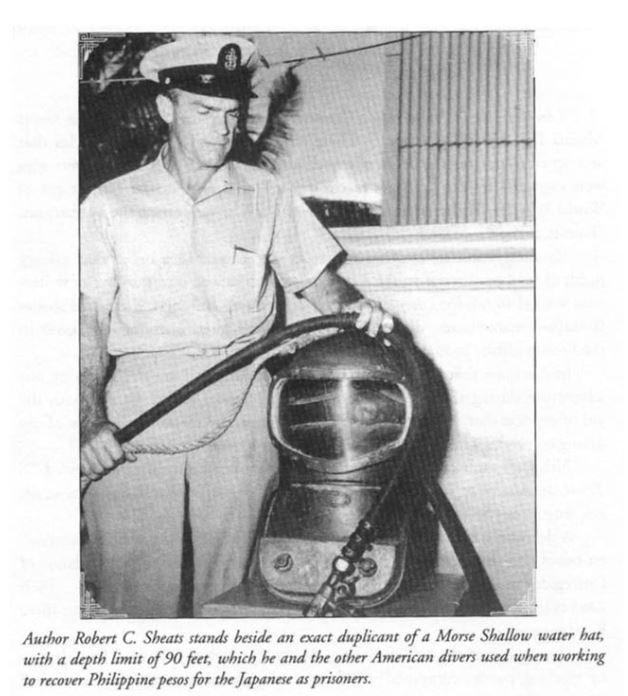
Zc284. Robert C Sheats with the Morse Shallow Water hat from this URL, click here!
Silver Salvage in Caballo Bay: Japan’s Sabotaged Treasure Hunt
—————————————
Silver recovery, Manila Bay, Life pictures on Facebook or click here:
https://www.facebook.com/photo/?fbid=1142747492770921&set=oa.3051498141579663
Here are only 4 images of many in the above URL!
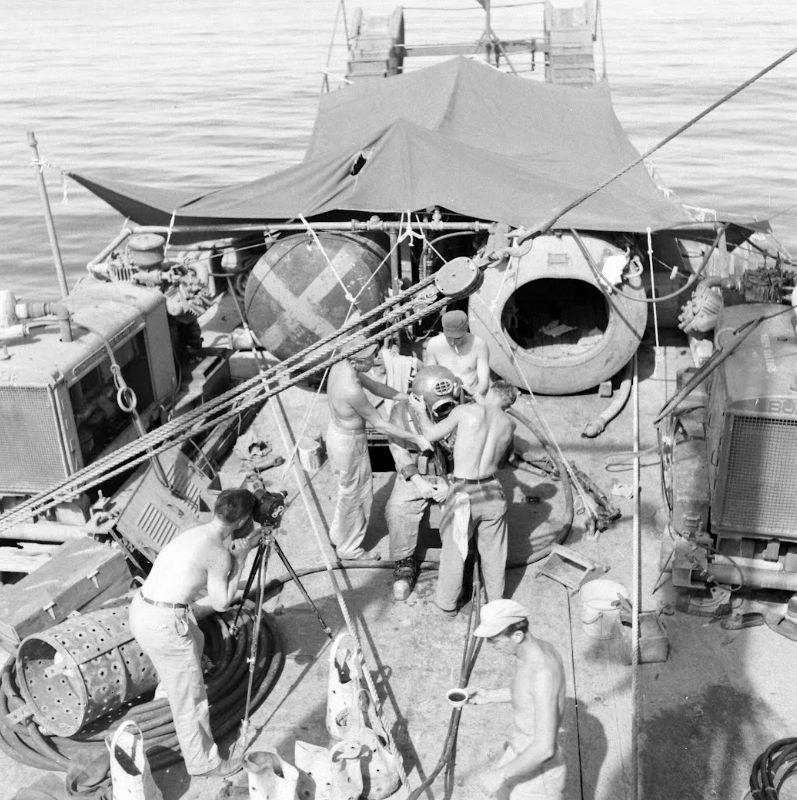
Zo584. This is or could be USS Teak AN-35 (Auxiliary Net-laying) at the Great Silver recovery operation in Manila Bay near Corregidor Island, the former Fort Mills in 1945. This is the focsle, compressors and recompression chambers are standing by. This is Life picture from the above Facebook URL.
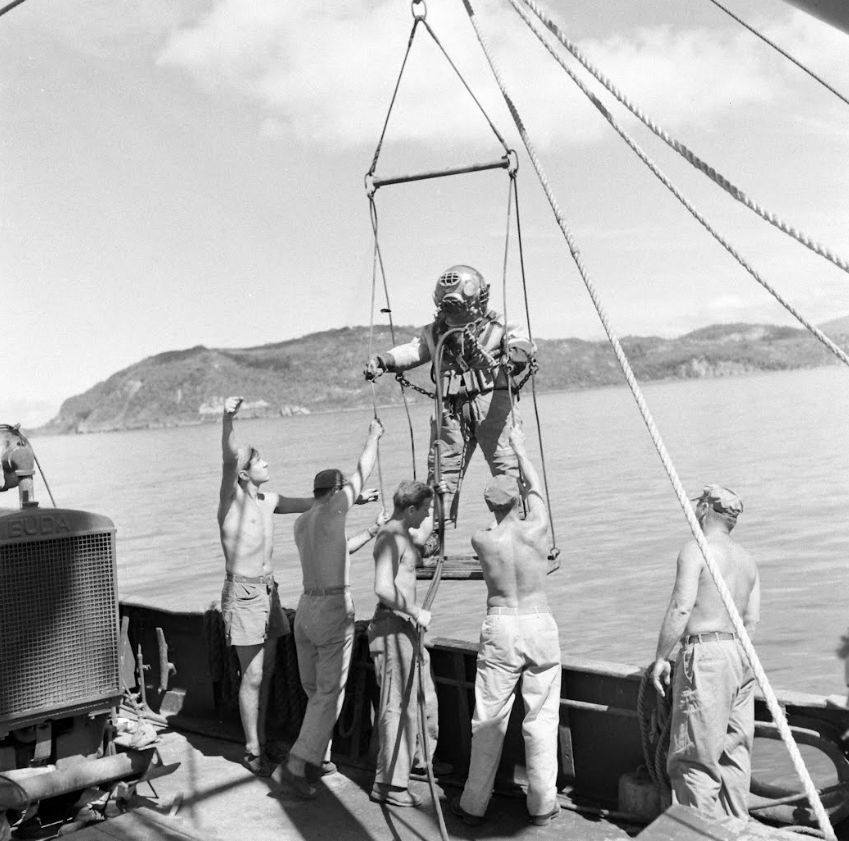
Zo585. This is or could be USS Teak AN-35 (Auxiliary Net-laying) at the Great Silver recovery operation in Manila Bay near Corregidor Island, the former Fort Mills in 1945. The ships boom is taking the Navy Hard Head Diver on a stage over the side. This is Life picture from the above Facebook URL.
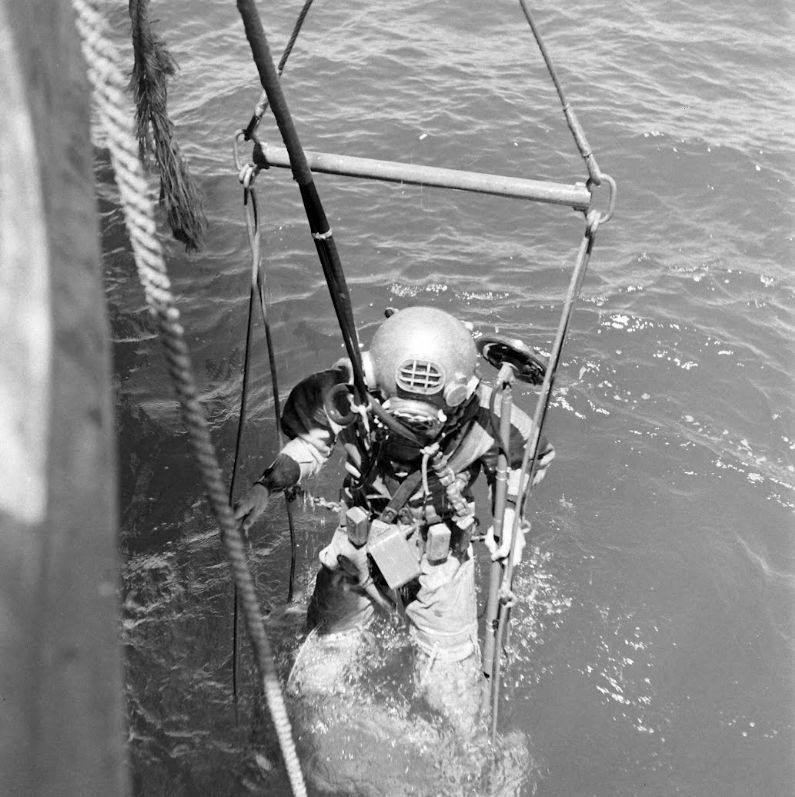
Zo586. This is or could be USS Teak AN-35 (Auxiliary Net-laying) at the Great Silver recovery operation in Manila Bay near Corregidor Island, the former Fort Mills in 1945. The diver is entering the water with the stage. The diver also decompresses on that stage. He seems to have a metal detecting device in hand. This is Life picture from the above Facebook URL.
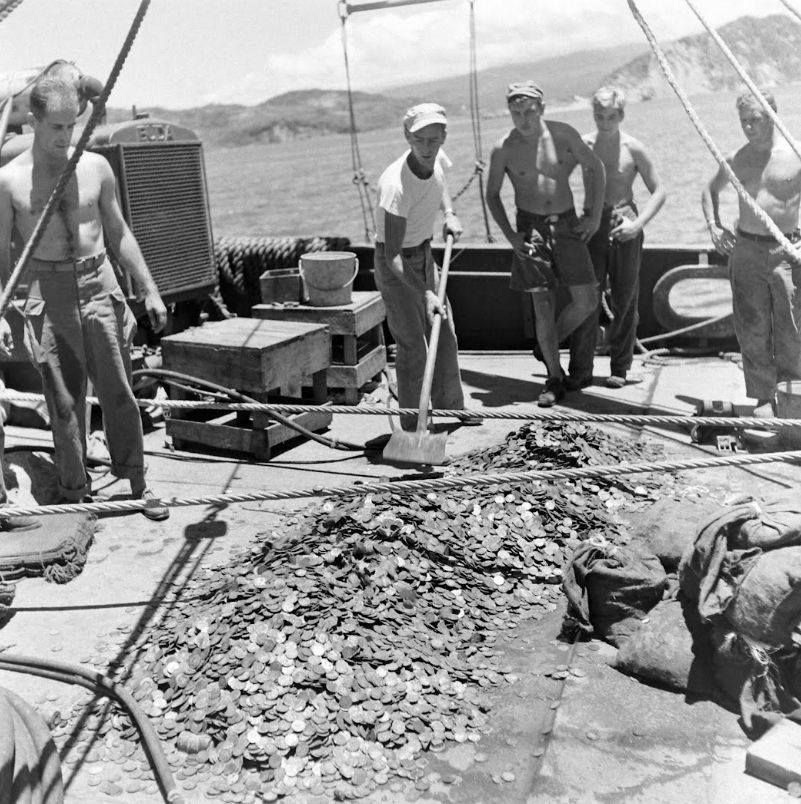
Zo587. This is or could be USS Teak AN-35 (Auxiliary Net-laying) at the Great Silver recovery operation in Manila Bay near Corregidor Island, the former Fort Mills in 1945. Shoveling the money to a heap on deck. That is the southside of Bottomside on Corregidor. This is Life picture from the above Facebook URL.
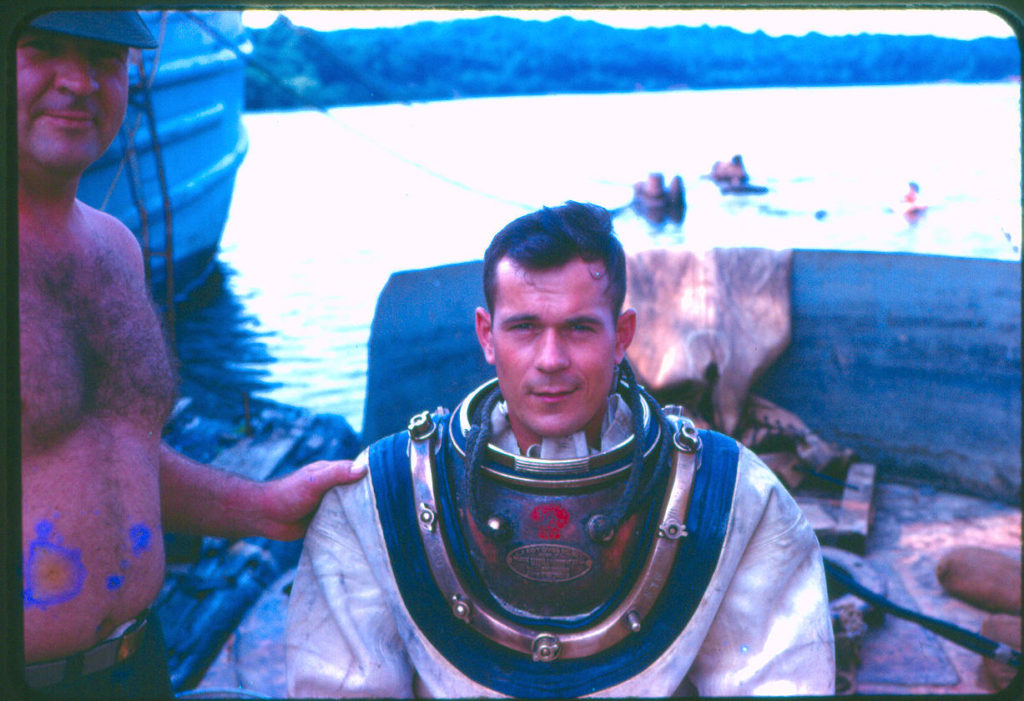
Zo588. Whoops, wrong picture! What the heck, that’s me as a First-Class Navy Deep Sea Diving Student on the Potomac River. We are doing our salvage training here 1969 at a deep spot in the river. This is also at the Naval Dahlgren Weapons Station and later, 1970, I helped here raising the ex USS Reuben James, which sunk here after explosion testing effects. This ship’s name also has a German WWII connection; an earlier Reuben James, a Destroyer, DD-245 was torpedoed in Oct 1941 by a German submarine with the loss of 100 men or more. The ship was doing convoys to Great Britain escort duty up to Iceland before the US entered the war. The ship was named after a Navy Boatswains Mate, that is what I was at the time, a Chief Boatswains Mate Diver, (BMC DV2).
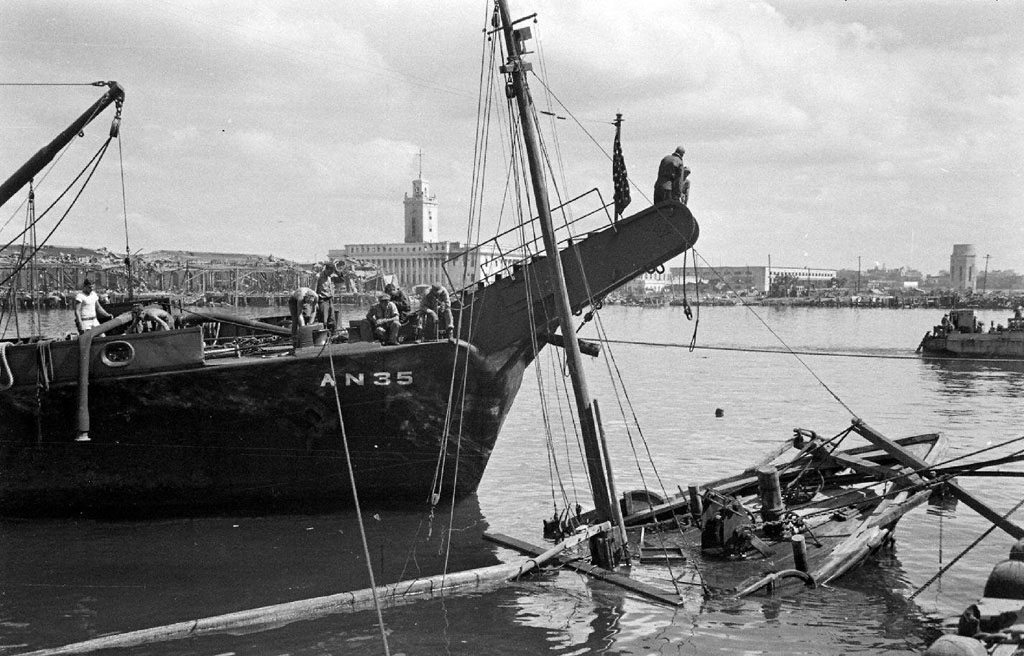
Zo589. This is USS Teak AN-35 (Auxiliary Net-laying) at salvage clearing operation in Manila Bay in 1945. This picture came from this URL, NavSource Online: Service Ship Photo Archive or click here:
http://www.navsource.org/archives/09/18/18035.htm
————————————————————–
GOLD IS ALSO BALLAST, Edward Michaud
The most comprehensive coverage of the Philippine Treasure on Corregidor is from the Corregidor.org web pages. Here is just one URL and I copied these pictures and descriptions from it or click here.
http://corregidor.org/chs_trident/ballast_01.htm
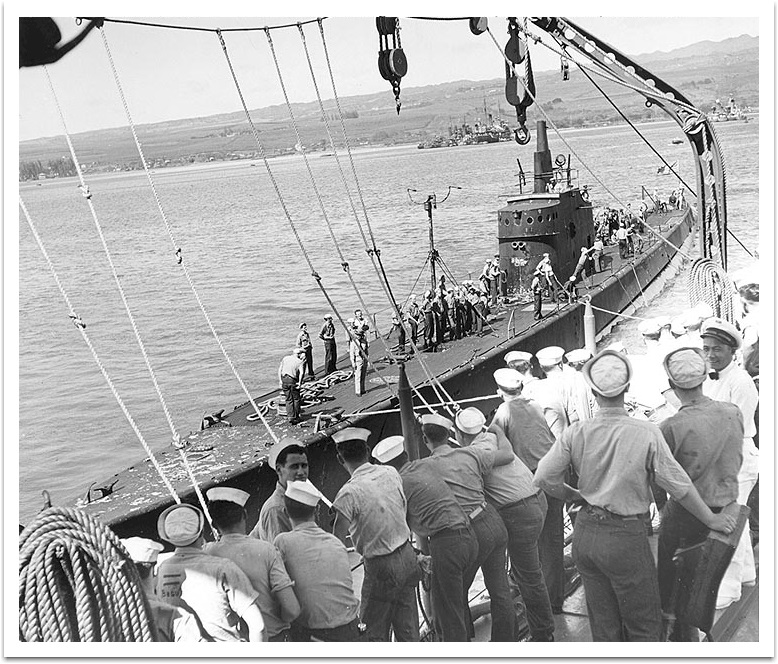
Zo593. USS Trout (SS-202) approaches USS Detroit (CL-8) at Pearl Harbor in early March 1942, to unload a cargo of gold that she had evacuated from the Philippines. The gold had been loaded aboard Trout at Corregidor on 4 February 1942.
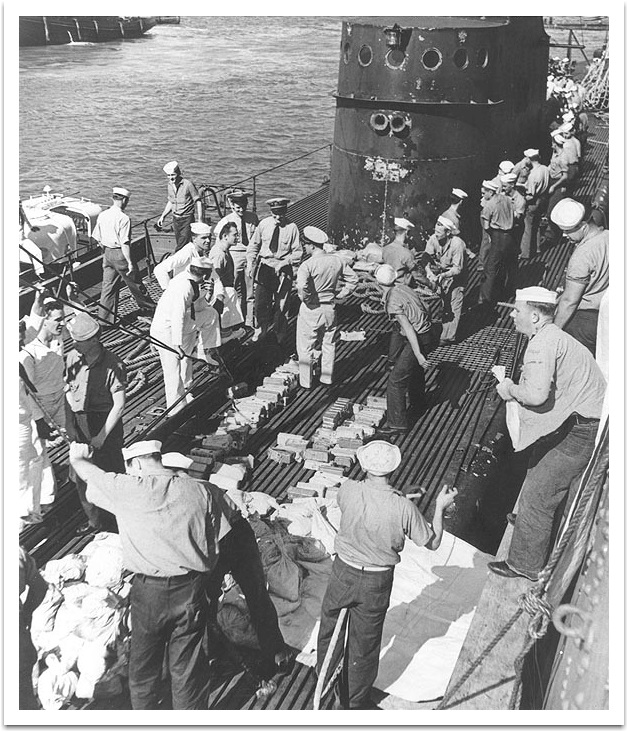
Zo594. USS Trout (SS-202) at Pearl Harbor in early March 1942, unloading gold bars which she had evacuated from Corregidor.
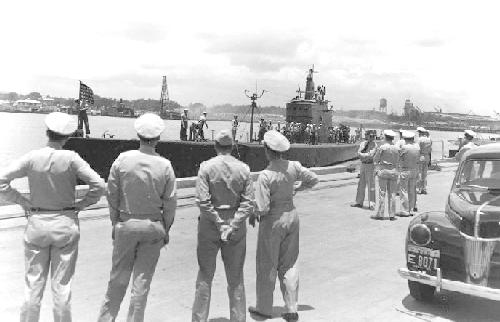
Zo595. USS Trout (SS-202) returns to Pearl Harbor on 14 June 1942, after the Battle of Midway. She is carrying two Japanese prisoners of war, Chief Radioman Hatsuichi Yoshida and Fireman 3rd Class Kenichi Ishikawa, survivors of the sunken cruiser Mikumawho had been rescued on 9 June. Among those waiting on the pier are Rear Admiral Robert H. English and Admiral Chester W. Nimitz. The district ferry Nihoa (YFB-19) is in the left background, just to the right of Trout’s jack. Two .30 caliber Lewis machineguns are mounted on Trout’s sail, flanking the periscope shears.
I add this URL from Corregidor.org because on the bottom of the page are just about all the relevant links listed or click here:
http://corregidor.org/chs_trident/trident_03.htm
—————————————————–
The Golden Patrol of the USS Trout SS-202
As I said before, corregidor.org. web pages have the most comprehensive story about the treasure on Corregidor. Here is another link, written by Ensign John L. Dettbarn, USN; or click here:
http://corregidor.org/chs_trident/uss_trout.htm
The story original came from the U.S. Naval Institute
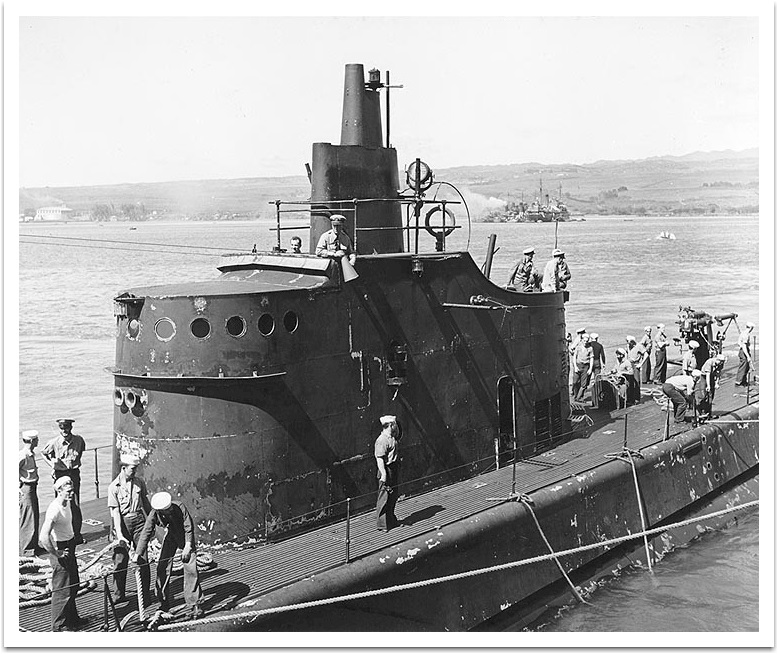
Zo596. USS Trout (SS-202) coming alongside USS Detroit (CL-8) at Pearl Harbor in early March 1942, to unload a cargo of gold that she had evacuated from the Philippines. The gold had been loaded aboard Trout at Corregidor on 4 February 1942. Note details of the submarine’s fairwater, and .30 caliber Lewis machine gun mounted aft of the periscope housing.
National Archives Photo No. 80-G-45971. Department of the Navy – Naval History and Heritage Command.
National Archives Photo No. NH-50388. Department of the Navy – Naval History and Heritage Command.
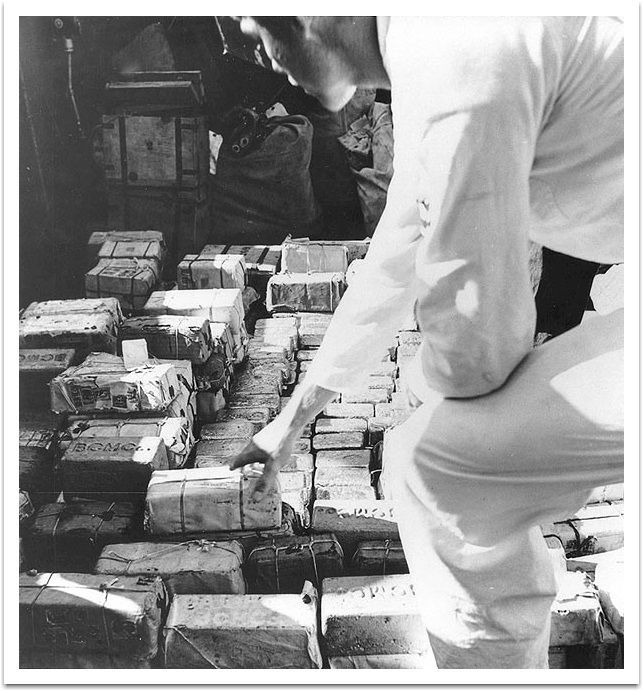
Zo597. Unloading gold bars from USS Trout at Pearl Harbor, March 1942. USS Trout (SS-202) at Pearl Harbor in early March 1942, unloading gold bars which she had evacuated from Corregidor.
National Archives Photo No. 80-G-45970. Department of the Navy – Naval History and Heritage Command.
Regrettable, sadly, most of these Sailors went on their final patrol in 1944!
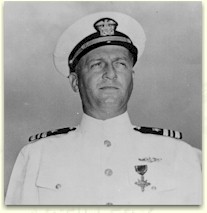
Zo598. USS Trout (SS-202) was credited with sinking 23 enemy ships, giving her 87,000 tons sunk, and damaging 6 ships, for 75,000 tons. She received a Presidential Unit Commission for the Gold patrol (her 2nd.) During her first ten patrols she made 32 torpedo attacks, firing 85 torpedoes, including 34 hits, 5 confirmed premature detonations, 5 confirmed duds, and 25 suspected duds. She was also involved in six battle surface actions and was attacked with depth charges eight times. She was reported overdue on 17 April 1944 and presumed lost on her eleventh war patrol, with all 81 hands. LCDR Frank Wesley (Mike) Fenno (pictured) was awarded the DSC for the Gold cruise, and the entire crew were awarded the Silver Star by the Army. Trout was lost on its 7th patrol when under the command of LCDR A. H. Clark. Fenno had transferred to Pampanito. He survived the war and retired as a Rear Admiral.
Here are a few select sentences from the above URL:
This was the mission of USS Trout. She was to leave Pearl Harbor carrying 3,500 rounds of mechanically-fuzed, high altitude ammunition for the defenders of Corregidor.
During the withdrawal to the “Rock,” vast amounts of gold, silver, and securities were sent to Corregidor for safekeeping.
The amount of wealth accepted by Sayre was staggering. There were 18,000 Treasury checks totaling $38,000,000 which had been received by the Philippine Treasury for payment and had not been sent to the United States for credit. In addition to these securities, there was on Corregidor a large amount of gold, silver, securities, and government documents as yet not been turned over to the Commissioner. These had served as the Philippine Commonwealth reserves and comprised over one-and-a-third million grams of gold and nearly sixteen and one-half million silver pesos. A rough summation of the valuables collected under the first War Powers Act was nearly $3,000,000 in American currency, $28,000,000 in Philippine currency and 10,800 pounds of gold. The paper currency was easily disposed of by burning after the serial numbers had been recorded and radioed to the United States.
At 1945 hours, Commander Fenno rendezvoused with Lieutenant John D. Bulkeley, USN. The motor torpedo boat squadron commander came on board, and ten minutes later Trout was following the P.T’s wake through the minefields surrounding Corregidor. T. C. Parker, naval aide for the High commissioner, woke up Philippine Vice President Sergio Osmena and members of the High Commissioner’s Staff. Perhaps gold bullion would serve just as well. Here was the answer to several problems. Trout would receive her ballast and Commissioner Sayre would be rid of his gold. After clearance with General MacArthur by phone, it was arranged to transfer the gold bullion, securities, and some silver to Trout for ballast and ultimate delivery to Pearl Harbor for eventual transfer to the United States for the duration of the war.
With the impending collapse of Corregidor, General Wainwright still found himself with what he estimated to be $140,000,000 in Philippine currency and $15,000,000 in highly negotiable silver. As pointed out earlier, most of the paper currency was burned, but the problem of the silver pesos was solved by dumping 350 tons of them in the Bay,and the location of the dump radioed to Washington. Since then, most of the silver off Corregidor has been salvaged by the Seventh Fleet Ship Salvage Group. The Japanese recovered over 2,000,000 pesos by November 1942, but they then ceased operations.
The Philippine Government Treasury Vault on Corregidor
Here, in great haste, the Philippine gold, silver, paper money and securities were evacuated to, just before the Japanese occupied Manila.
The history of the Philippine Government Treasuries is described in this book:
I was on Corregidor by Amea Willoughby 1943 Harper & Brothers Publishers. She was the spouse of the Treasuries Assistant to the American High Commissioner to the Philippine Commonwealth.
Two of our dear Corregidor Forum members, Phantom and pdh54 have contributed to this forum thread, called Corregidor myths and legends. This thread has already 6 pages. This is the URL for page 4 which deals with the treasury vault or click here:
Corregidor myths and legends.
https://corregidor.proboards.com/thread/1002/corregidor-myths-legends?page=4
It is fascinating reading!
Where on Corregidor was the vault?
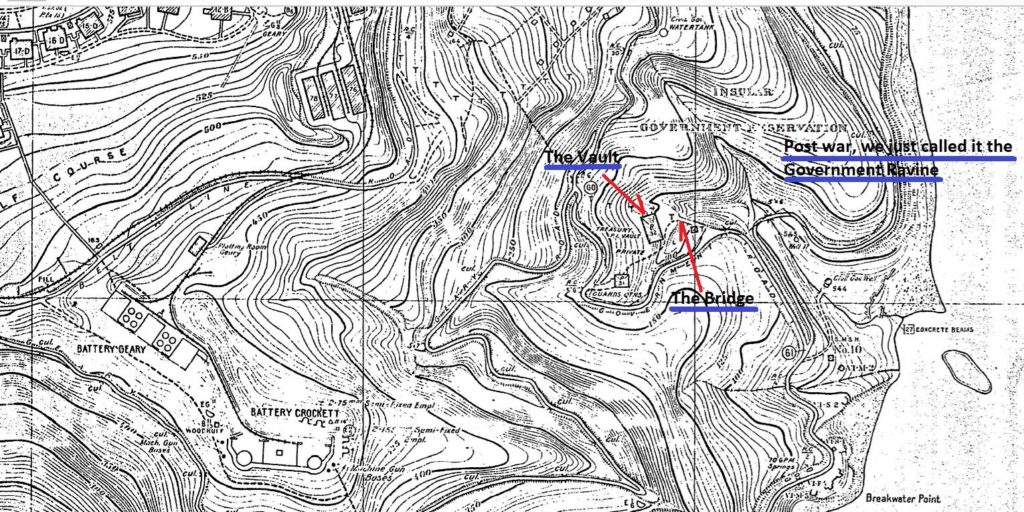
Zo621. A cropped section of the 1936 Fort Mills map on Corregidor Island showing the Insular Government Reservation. We post war visitors just called it the Government Ravine.
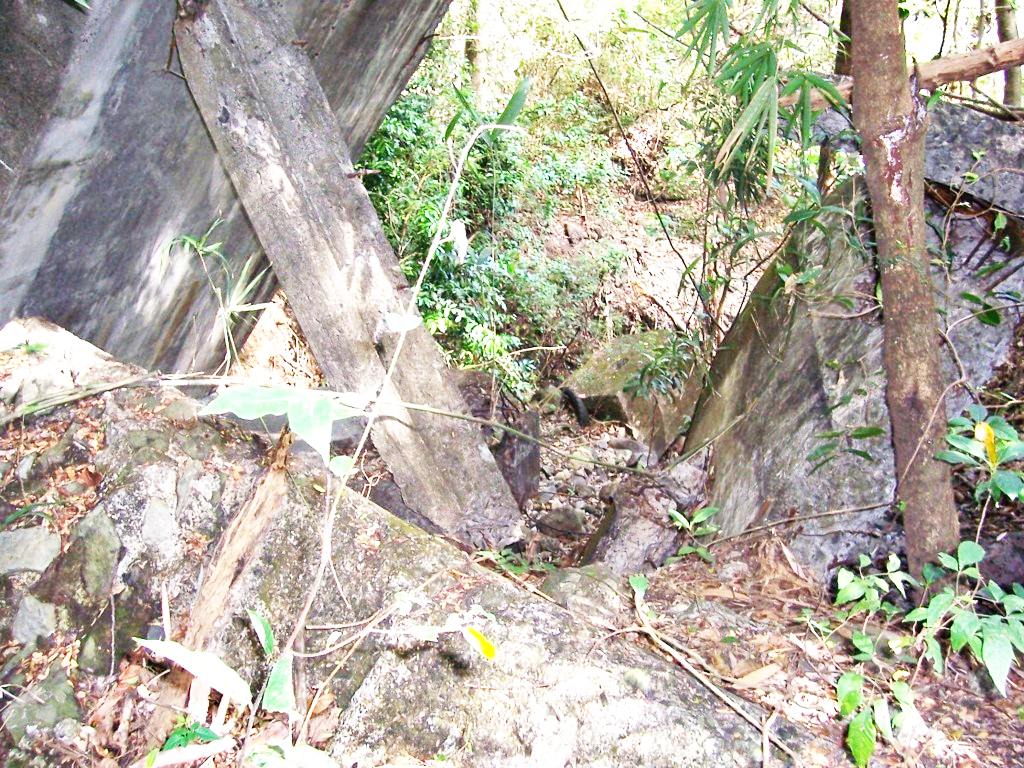
Zo622. There was a bridge to cross, over a side ravine, to reach the Philippine Government Vault. During the TWO BATTLES OF CORREGIDOR, 1942 and 1945 the bridge got destroyed.
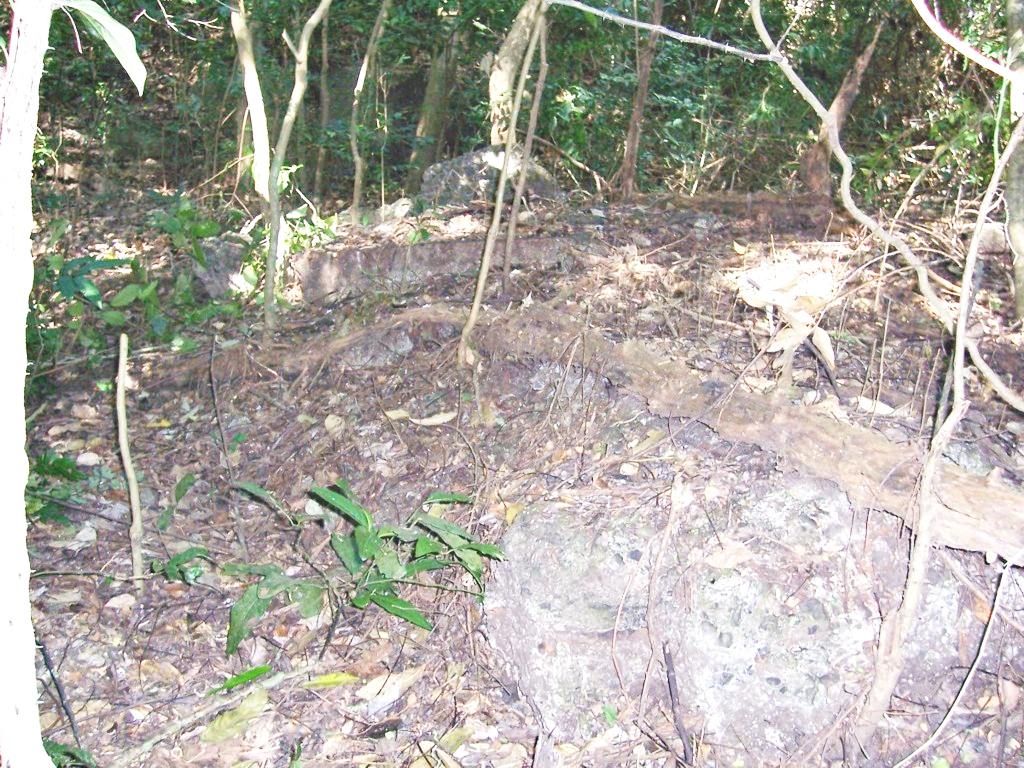
Zo623. The Philippine Government Vault in Fort Mills, on Corregidor during the TWO BATTLES OF CORREGIDOR, 1942 and 1945 also got destroyed.
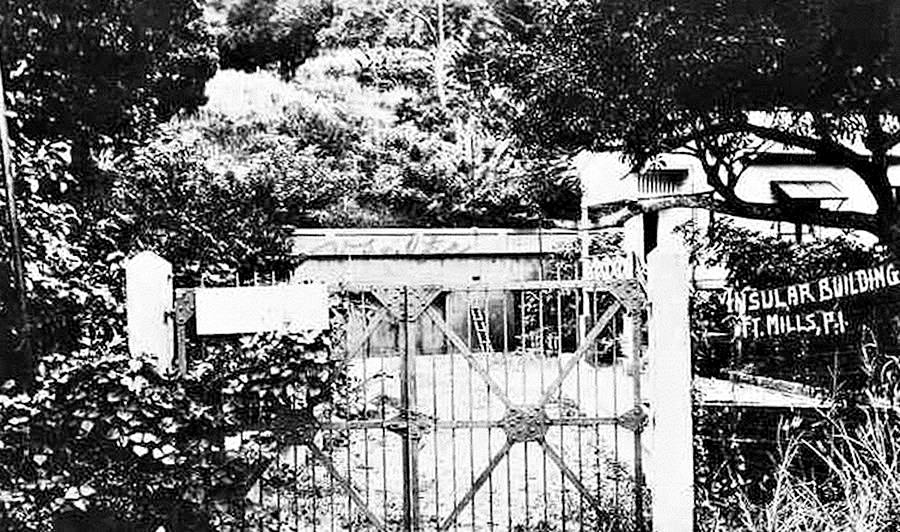
Zo624. This is the gate to Philippine Insular Government Vault in Fort Mills, on Corregidor Island before the war. My friend fots2 is another great contributor to the Corregidor forum and provided this picture which is also posted in the above URL which I repeat it here or click here:
https://corregidor.proboards.com/thread/1002/corregidor-myths-legends?page=4
It is really interesting reading and let me just copy two short paragraphs:
Patty, aka pdh54, Jul 6, 2012 at 3:52am, made this entry:
From Corregidor The Saga of a Fortress by James H. Belote and William M. Belote
Chapter 15 The Long Wait page189
“In their version of “graceful living” the Corregidor Japanese forced their captives to convert the old Philippine Government treasury vault, where the gold and silver had been stored, into an eight-room brothel, in which they confined seven prostitutes from Manila. They lured the girls into coming with the promise of high pay, and then refused them permission to leave. Such an installation on a military post caused wonderment among the American prisoners and much comment in their diaries.”
Amea Willoughby, 1943 writes and pdh54 presents (read it yourself in the above URL):
I wanted very much to be let into the vault and to see the gold. But it was not the safest of places. For one thing it was not bombproof. And a bit higher up on the same hill was one of the biggest batteries on Corregidor. When the battery let off its twelve-inch mortars the shock in the vault was so terrific that the men working there said it lifted them six inches off their chairs. The Japanese knew the approximate location of this battery it was one of their favorite shelling targets. Sometimes shells whistled overhead every two minutes all day long.
At long last I persuaded Woody to take me to see the vault. We drove up from the tunnel to a charming little green bower where the vault was snugly hidden under leafy luxuriant foliage. I had to look sharply to pick out the low, heavy door and barred windows right in front of me. There were guards pacing in front of the entrance, and there was Mrs. Wingate’s house on the right, at the top of a small rise in the ground.
Inside the vault one felt entombed within the oppressively low stone ceilings, as one did in the tunnel, but the air was fresher. A few rays of daylight struggled wanly through the small barred windows into two or three cellar-like rooms of fair size. The only real light came from electric light bulbs hanging nakedly on long cords.”